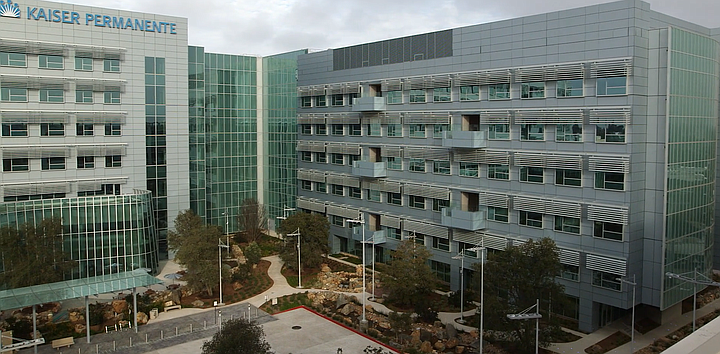 Facebook
Facebook
 X
X
 Instagram
Instagram
 TikTok
TikTok
 Youtube
Youtube

The Coalition of Kaiser Permanente Unions warned in an August 12 press release they are planning the “nation’s largest walkout since 1997.” Coalition spokesman Sean Wherley says over 80,000 Kaiser Permanente employees in six states and D.C. may go on strike at their hospitals and clinics in early October.

This includes 4,916 caregivers and service and maintenance workers in San Diego County who belong to the Office and Professional Employees International Union Local 30. They will be voting September 16-20 whether to authorize an “unfair labor practice” strike. Wherley says the Service Employee International Union - United Healthcare Workers West, which represents 57,000 Kaiser employees from the rest of California, already voted in early August and 98 percent of voters authorized a strike.
Wherley says the national contract with Kaiser expired September 30, 2018 and Kaiser was supposed to start negotiating in April 2018 but refused until earlier this year. He says the local contracts will expire September 30, 2019.
According to Local 30 charts issued to members, Kaiser is proposing three percent pay raises each year for four years to California workers and a 15 percent pay cut for new hires. Workers outside California are offered one-two percent raises. The coalition is counter-proposing a five-year agreement with yearly raises of four, three, three, four, and four percent for workers in all regions, and no pay cuts for new hires.
Elita Adjei, director of media relations for Kaiser Permanente Southern California, says the strike threat is just a bargaining tactic. She says, “Coalition-represented employees are already compensated 23 percent above market rates...The coalition’s proposal would actually increase our wages on average 32 percent above the market over the next five years, adding $1 billion to our labor costs. At a time when we are working hard to keep our care affordable, the coalition’s demands are not fair to our members and the communities we serve.”
Wherley says Kaiser made $5.2 billion in profits in the first six months of 2019 and has $35 billion in reserves. He says, “They pay 36 executives more than $1 million a year and the CEO gets $16 million, which is unheard of for a non-profit.” He says instead of giving back to “the workers who made Kaiser successful and elevated patient care...they have plans to build a new high-rise headquarters in Oakland for $900 million.” He adds Kaiser is planning what he calls a “vanity project” called “Thrive City,” an outdoor plaza in San Francisco in partnership with the Golden State Warriors.
According to data from the California Health and Human Services Agency, in 2017 Kaiser had 34 hospitals and the largest operating margin for a non-profit hospital system at 11.1 percent. The average operating margin for a for-profit hospital system in California was 9.6 percent. Scripps Health was second to Kaiser among non-profits with a 10.1 percent operating margin but only four hospitals. Non-profit Sharp Healthcare had six hospitals and an operating margin of 6.1 percent.
Adjei says Kaiser’s contract proposal “preserves the existing defined pension plan along with other strong retirement benefits” and includes “a more robust tuition reimbursement program.” She indicates the two sides agree on “a $40 million Workforce Development Fund and creation of new-hire training positions, all part of the solution to address the national shortage of healthcare workers…”
Wherley says another union demand is for Kaiser to “protect middle class jobs” by prohibiting outsourcing and automation of jobs, two things Kaiser wants to be free to do. And he says, workers want to return to the non-profit mission, including service to low income patients. “In 2017 the volume of Medi-Cal patients at Kaiser hospitals was eight percent. Compare to other non-profits where the average was 27 percent. Of 25 hospitals with the lowest percentage of Medi-Cal patients, 18 are owned by Kaiser.”
The state of California Department of Health Care Services sends Medi-Cal patients the results of a survey taken by existing patients of their different health care plans, Kaiser scored significantly higher than other health care plans, getting the highest score in every category except shared decision making. I asked Adjei about Kaiser’s share of Medi-Cal patients. She did not respond.
According to jacobinmag.com 185,000 Teamsters went on strike against United Parcel Service in 1997. Wherley says the coalition of 80,000 Kaiser employees would be the largest strike since. In this case he says if the union bargaining committee decides to call a strike after receiving authorization from union members and failing to reach a deal with Kaiser, they would need to file a notice with the National Labor Relations Board ten days before starting the strike, so alternative arrangements can be made to provide care to patients. “The last thing workers want is to go on strike but they are left with no choice. Kaiser has the resources to resolve this today,” Wherley says.
Adjei says the potential strike requires Kaiser “to spend millions of dollars preparing for the threat of a strike event.” She says, “Our first priority is always continuity of care for our patients and members.”


The Coalition of Kaiser Permanente Unions warned in an August 12 press release they are planning the “nation’s largest walkout since 1997.” Coalition spokesman Sean Wherley says over 80,000 Kaiser Permanente employees in six states and D.C. may go on strike at their hospitals and clinics in early October.

This includes 4,916 caregivers and service and maintenance workers in San Diego County who belong to the Office and Professional Employees International Union Local 30. They will be voting September 16-20 whether to authorize an “unfair labor practice” strike. Wherley says the Service Employee International Union - United Healthcare Workers West, which represents 57,000 Kaiser employees from the rest of California, already voted in early August and 98 percent of voters authorized a strike.
Wherley says the national contract with Kaiser expired September 30, 2018 and Kaiser was supposed to start negotiating in April 2018 but refused until earlier this year. He says the local contracts will expire September 30, 2019.
According to Local 30 charts issued to members, Kaiser is proposing three percent pay raises each year for four years to California workers and a 15 percent pay cut for new hires. Workers outside California are offered one-two percent raises. The coalition is counter-proposing a five-year agreement with yearly raises of four, three, three, four, and four percent for workers in all regions, and no pay cuts for new hires.
Elita Adjei, director of media relations for Kaiser Permanente Southern California, says the strike threat is just a bargaining tactic. She says, “Coalition-represented employees are already compensated 23 percent above market rates...The coalition’s proposal would actually increase our wages on average 32 percent above the market over the next five years, adding $1 billion to our labor costs. At a time when we are working hard to keep our care affordable, the coalition’s demands are not fair to our members and the communities we serve.”
Wherley says Kaiser made $5.2 billion in profits in the first six months of 2019 and has $35 billion in reserves. He says, “They pay 36 executives more than $1 million a year and the CEO gets $16 million, which is unheard of for a non-profit.” He says instead of giving back to “the workers who made Kaiser successful and elevated patient care...they have plans to build a new high-rise headquarters in Oakland for $900 million.” He adds Kaiser is planning what he calls a “vanity project” called “Thrive City,” an outdoor plaza in San Francisco in partnership with the Golden State Warriors.
According to data from the California Health and Human Services Agency, in 2017 Kaiser had 34 hospitals and the largest operating margin for a non-profit hospital system at 11.1 percent. The average operating margin for a for-profit hospital system in California was 9.6 percent. Scripps Health was second to Kaiser among non-profits with a 10.1 percent operating margin but only four hospitals. Non-profit Sharp Healthcare had six hospitals and an operating margin of 6.1 percent.
Adjei says Kaiser’s contract proposal “preserves the existing defined pension plan along with other strong retirement benefits” and includes “a more robust tuition reimbursement program.” She indicates the two sides agree on “a $40 million Workforce Development Fund and creation of new-hire training positions, all part of the solution to address the national shortage of healthcare workers…”
Wherley says another union demand is for Kaiser to “protect middle class jobs” by prohibiting outsourcing and automation of jobs, two things Kaiser wants to be free to do. And he says, workers want to return to the non-profit mission, including service to low income patients. “In 2017 the volume of Medi-Cal patients at Kaiser hospitals was eight percent. Compare to other non-profits where the average was 27 percent. Of 25 hospitals with the lowest percentage of Medi-Cal patients, 18 are owned by Kaiser.”
The state of California Department of Health Care Services sends Medi-Cal patients the results of a survey taken by existing patients of their different health care plans, Kaiser scored significantly higher than other health care plans, getting the highest score in every category except shared decision making. I asked Adjei about Kaiser’s share of Medi-Cal patients. She did not respond.
According to jacobinmag.com 185,000 Teamsters went on strike against United Parcel Service in 1997. Wherley says the coalition of 80,000 Kaiser employees would be the largest strike since. In this case he says if the union bargaining committee decides to call a strike after receiving authorization from union members and failing to reach a deal with Kaiser, they would need to file a notice with the National Labor Relations Board ten days before starting the strike, so alternative arrangements can be made to provide care to patients. “The last thing workers want is to go on strike but they are left with no choice. Kaiser has the resources to resolve this today,” Wherley says.
Adjei says the potential strike requires Kaiser “to spend millions of dollars preparing for the threat of a strike event.” She says, “Our first priority is always continuity of care for our patients and members.”
Comments